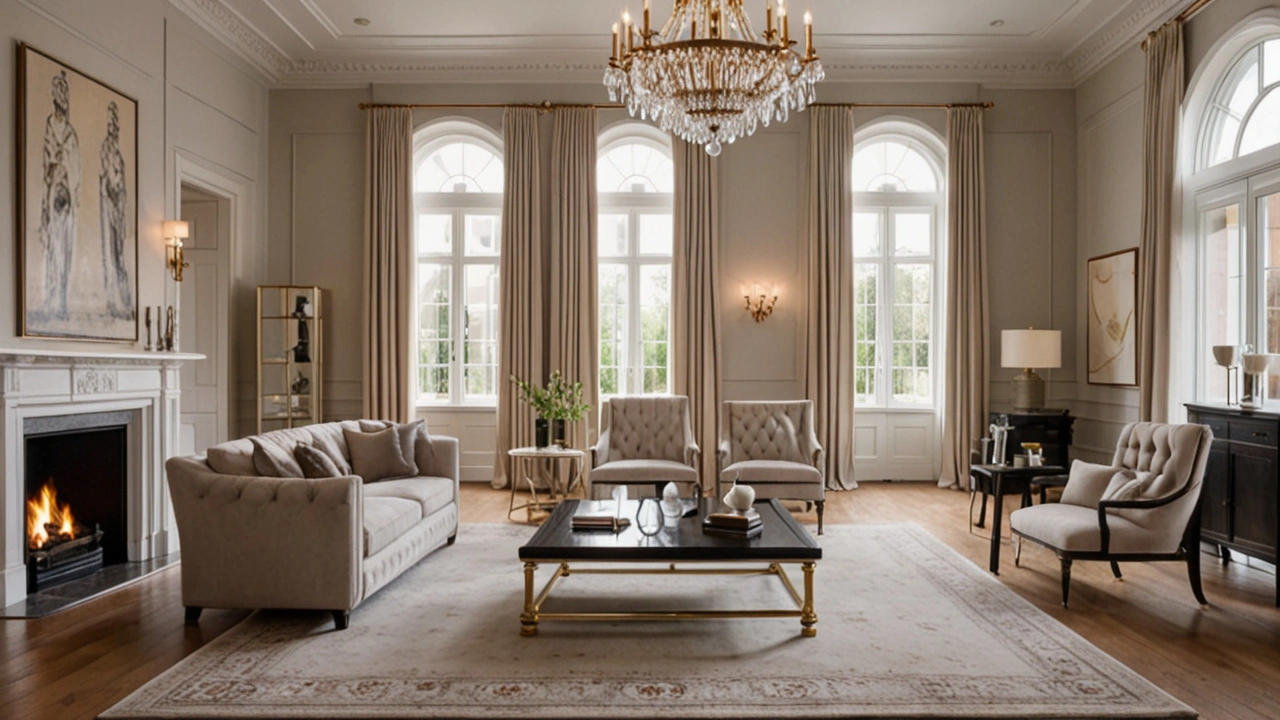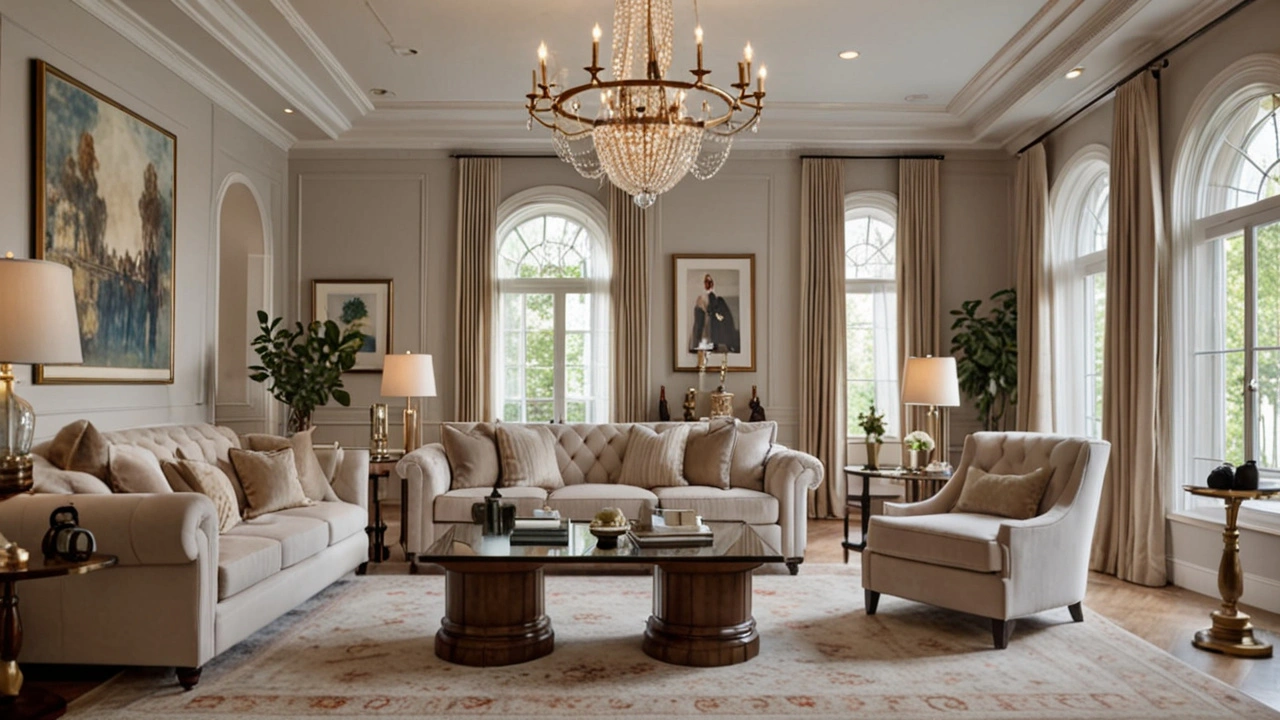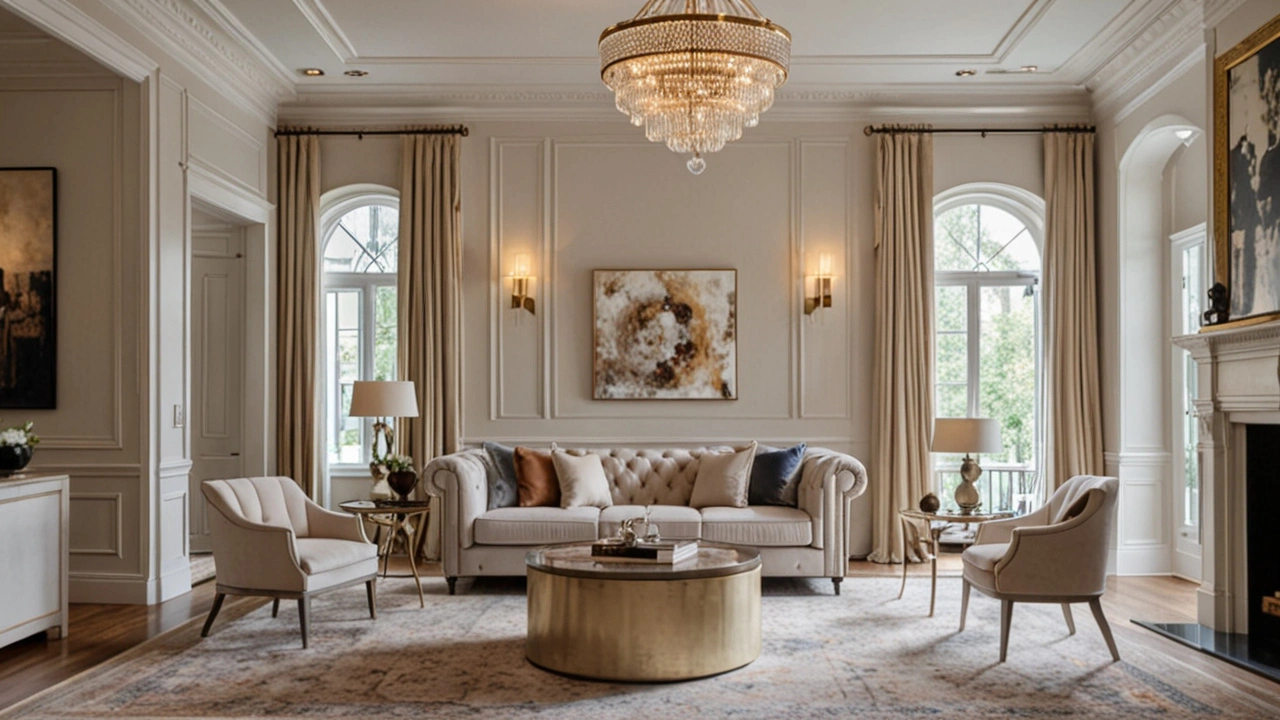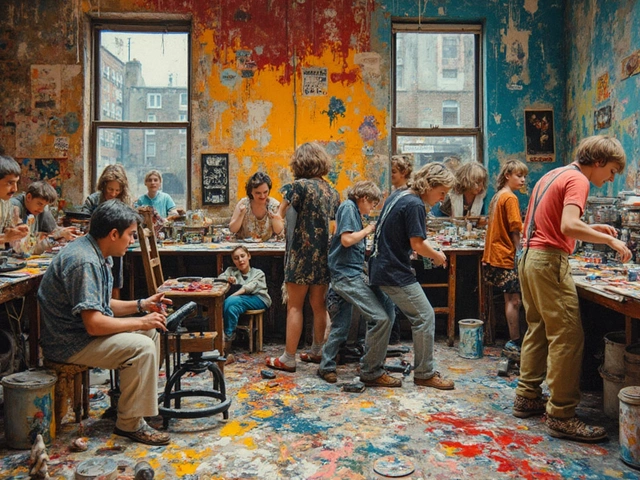Classicism in contemporary interior design is more than just a trend; it's a celebration of heritage and elegance in modern homes. Blending timeless elements with today's aesthetics, this approach creates spaces that are both sophisticated and livable.
Whether you are renovating an old home or simply want to introduce elements of classicism into your modern space, understanding the core principles can help you achieve the perfect balance. From architectural details like crown moldings and wainscoting to carefully chosen furniture pieces, each aspect plays a crucial role. Beautifully coordinated color schemes and thoughtfully selected accessories tie everything together, making the space feel cohesive and elegant.
- Understanding Classicism
- Incorporating Architectural Details
- Choosing the Right Furniture
- Balancing Color Schemes
- Accessorizing for Elegance
Understanding Classicism
Classicism in interior design draws its inspiration from the architecture and art of ancient Greece and Rome. It emphasizes symmetry, order, and balanced proportions, seeking harmony in every element. This style has stood the test of time because of its elegance and ability to evoke a sense of history and permanence.
One of the defining characteristics of classicism is its use of architectural elements like columns, cornices, and moldings. These features not only add grandeur but also frame spaces in a way that feels intentional. Column designs often mimic those found in Greek and Roman temples, lending a stately air to interiors. Cornices and moldings, adorned with intricate detailing, draw the eye upward, enhancing the perception of height and space in a room.
A classic interior also frequently utilizes materials like marble, wood, and stone. These natural materials not only bring in texture but create a sense of luxury and durability. Marble, for instance, is often used in flooring, fireplaces, and even furniture. Its cool, polished surface adds a touch of sophistication and timeless beauty.
Color schemes in classicism are typically composed of muted, neutral tones. Think whites, creams, beiges, and grays as primary colors, with occasional splashes of gold, bronze, or rich, dark shades used as accents. This restrained palette creates a calm and cohesive environment, allowing the architectural details and craftsmanship to take center stage.
In a modern context, classicism is often adapted to fit contemporary sensibilities. This involves simplifying some of the more ornate details and integrating modern conveniences without losing the essence of the style. The result is a space that feels both timeless and current, offering the best of both worlds.
Incorporating classicism into your home doesn’t require a complete overhaul. Even small touches, like adding a gilded mirror or a classical-inspired piece of art, can introduce elements of this style. The key is to focus on quality and intentionality, ensuring that each piece contributes to the overall harmony and balance of the space.
Understanding the principles of classicism can provide a strong foundation for creating stunning interiors that transcend trends. Whether you choose to go all-in or simply introduce a few elements here and there, embracing classicism can transform your home into a sanctuary of elegance and grace.
Incorporating Architectural Details
One of the most striking ways to bring classicism into your contemporary home is by incorporating architectural details that echo the elegance of past eras. These elements are not just about aesthetics; they also communicate a sense of history and permanence. Traditional features such as crown moldings, wainscoting, and coffered ceilings are classic examples that can be seamlessly integrated into modern interiors.
Crown moldings are perhaps the most recognizable classical architectural detail. They bridge the wall and ceiling, often with intricate designs that draw the eyes upwards, adding height and grandeur to any room. When choosing crown moldings, it's crucial to consider the scale and proportion of the space. For smaller rooms, simple moldings with less intricate designs work best. Larger spaces can handle more elaborate patterns without feeling overwhelmed.
Wainscoting is another powerful tool for adding classical charm. It involves applying wooden panels to the lower half of the walls, which can be left plain or embellished with carvings. This method not only adds visual interest but also protects the walls from scuffs and marks. Wainscoting can be painted in neutral tones for a subtle effect or in bold colors to create a statement piece. Either way, it provides a textural element that creates depth and character.
Coffered ceilings are a key element in classical architecture. These consist of a series of sunken panels in a grid pattern, often adorned with detailed moldings. Coffered ceilings can make a dramatic impact, giving a room a sense of luxury and refinement. They work particularly well in larger spaces like living rooms or dining halls. For a modern twist, consider painting the panels in contrasting shades or incorporating recessed lighting.
Combining Old and New
Blending these architectural details with modern elements requires a careful balance. The key is to let these classical features shine without overwhelming the room. Contemporary furniture with clean lines can help offset the ornate nature of traditional architectural details. Mixing materials like wood, metal, and glass can also create a harmonious blend of old and new.
Lighting plays a significant role in highlighting these features. Use wall sconces and chandeliers that complement the architecture to draw attention to moldings and wainscoting. Recessed lighting in coffered ceilings can add a softer, modern ambiance to a room. Mirrors strategically placed can also reflect architectural details, enhancing their presence in the space.
"Architectural details are the backbone of classical design; they create the atmosphere and set the stage for all other elements," says renowned interior designer Jeffrey Bilhuber.Integrating these timeless architectural elements into your home doesn't mean you have to live in the past. When done right, these details add a layer of sophistication and history to modern spaces, creating a home that feels grounded yet contemporary.

Choosing the Right Furniture
Furniture plays a pivotal role in achieving the balance between classicism and modern design. The pieces you select should embody timeless elegance while being functional for contemporary living. Start by looking for furniture that has classical lines and details. Think about pieces with ornate carvings, sturdy wooden construction, and rich fabrics. Such elements have stood the test of time and can bring a sense of history and sophistication into a room.
Remember that the key to blending these two styles is contrast. Pair a vintage wooden dining table with sleek, modern chairs. This combination allows both classic and modern elements to stand out. When selecting upholstery, look for high-quality materials with a blend of traditional patterns and modern colors. Fabrics like velvet or silk can add a touch of luxury.
A great concept to consider is proportion and scale. Classic furniture often has larger, more commanding dimensions, while modern pieces tend to be sleeker and more compact. Balancing these proportions can make a room feel harmonious. For example, balance a large, ornate sofa with streamlined, minimalist coffee tables. This not only distributes visual weight but also keeps the room from feeling too one-dimensional.
Choosing the right materials is another critical aspect. Classicism favors natural materials like wood, stone, and leather. Incorporating these into modern interiors can create a rich texture palette. Use wooden furniture with intricate designs to add depth, while marble or granite countertops can add an air of timelessness to kitchens and bathrooms.
Importantly, ensure comfort and functionality are not sacrificed for style. Classicism should blend seamlessly with modern life. For example, a beautiful antique armchair is great, but consider reupholstering it with a durable fabric that can withstand daily use. Transforming traditional pieces to meet contemporary needs is key.
"Furniture must have personality, as well as be beautiful," asserts Rose Tarlow, a renowned interior designer. Her perspective highlights the importance of finding pieces that resonate on a personal level while maintaining aesthetic appeal.
Finally, don’t be afraid to mix and match. Eclectic combinations often yield the most stunning results. A modern glass coffee table can look fabulous next to a baroque-style armchair. It’s all about finding that cohesive middle ground where old meets new and creating a space that feels both inviting and stylish.
Balancing Color Schemes
When it comes to classicism in interior design, balancing color schemes is a masterful art. The right colors can enhance the feeling of timeless elegance, making a room feel both sophisticated and inviting. To achieve this, one must understand the principles behind classic and contemporary color palettes. Traditional colors often include shades like deep burgundy, navy blue, forest green, and rich browns. These colors are known for their depth and ability to create a warm and stately ambiance within a room.
In a modern setting, these traditional hues can be balanced with neutral tones such as beige, taupe, and crisp white. This combination brings a sense of lightness and openness to spaces that might otherwise feel heavy or overly formal. When integrating classic colors into a contemporary space, consider using them on larger pieces of furniture or as an accent wall while keeping the rest of the room neutral. This approach allows for a stark contrast that feels both balanced and harmonious.
In creating a cohesive color scheme, it's essential to pay attention to the undertones of each color. For instance, a warm-toned beige will pair better with warm colors like golden yellows and rich reds rather than cool blues or greens. This attention to detail ensures that the overall look is harmonious. If you're unsure about which colors to choose, consider looking to nature for inspiration. Green foliage and blue skies have been paired with earthy browns and stone grays for centuries, naturally creating pleasing palettes that never go out of style.
One trick used by designers is the 60-30-10 rule. This means using 60% of a dominant color, 30% of a secondary color, and 10% of an accent color. This formula helps maintain balance and prevents any one color from overwhelming the room. For example, you might choose to paint the walls a soft beige (60%), add a navy blue sofa and curtains (30%), and then use gold or brass elements for accessories (10%). This rule isn't just for walls and fabrics; it also applies to furniture, rugs, and even artwork.
Layering different hues and textures within each color family can add depth and interest to your space. For instance, if you are using blue, don’t be afraid to mix navy, sky blue, and teal together. This technique gives a dynamic quality to the room and prevents it from feeling flat or monotone. Textural elements such as a velvet cushion, a silk curtain, or a wool rug also contribute to the richness of the design. These different materials catch the light in various ways, making the colors appear more nuanced and multidimensional.
Another compelling way to balance color is through the use of patterns. Classic designs like damask, toile, and stripes have stood the test of time and can seamlessly blend into modern interiors. When working with patterns, it's essential to keep the scale in mind. A large damask print might be perfect for a feature wall, while a smaller geometric pattern could be better suited for accent pillows or a throw. Mixing and matching patterns can create a visually stimulating environment, but it's crucial to stick to one or two main colors to tie everything together.
As said by Frank Lloyd Wright, ‘Color is the where our brain and the universe meet.’ This principle rings true when creating a balanced color scheme that marries the classic with the contemporary. The careful selection and arrangement of colors can evoke emotions, set the mood, and bring a room together in an effortlessly chic manner.
To sum up, balancing classicism with contemporary elements using color schemes is about understanding which colors naturally complement each other and using these combinations to create a sophisticated, elegant space. By combining traditional hues with neutral tones, respecting the warmth or coolness of undertones, and employing strategic layering and patterns, one can achieve a harmonious and timeless interior.

Accessorizing for Elegance
When it comes to embracing classicism in contemporary interior design, the choice of accessories is paramount. Accessories turn a house into a home, and with the right selection, you can seamlessly blend both timeless charm and modern sophistication.
Start with art pieces. Opt for classic artworks that feature landscapes, portraits, or still life paintings. These can be framed elaborately with gold leaf or wooden frames that add a touch of grandeur. Often, a well-placed painting above a fireplace or a centerpiece in the living room sets the tone for the entire space.
Lighting is another crucial element. Choose chandeliers with crystal droplets or vintage-inspired sconces that cast a warm, inviting glow. These lighting pieces are not only functional but also act as statement decor. For instance, a crystal chandelier in a dining room can evoke the opulence of a bygone era, while modern LEDs ensure energy efficiency.
Incorporate mirrors to reflect light and add depth to rooms. Ornate, gilded mirrors can create a sense of space and luxury. Place them opposite windows to maximize natural light, or use them as focal points in hallways and entryways.
Textiles play a significant role in accessorizing. Look for throw pillows, curtains, and rugs with classic patterns like damask, toile, or paisley. These patterns can complement solid, neutral furnishings, adding layers of texture and visual interest. Genuine Persian or Oriental rugs can anchor a room’s decor, grounding it in timeless elegance.
In the realm of smaller accessories, consider antique clocks, porcelain vases, and classic figurines. These items can be displayed on mantels, shelves, or side tables to convey a sense of history and character. Even modern spaces can benefit from these nostalgic touches, providing a link to the past.
Functional yet stylish, these accessories should not be overwhelming. Balance is key: avoid clutter, and instead focus on a few impactful pieces. Remember, elegance is defined by simplicity and refinement.
Plants and flowers also make excellent accessories. Think of arrangements of roses, peonies, or hydrangeas in fine china vases. Fresh flowers bring life and color to any room, and their fragrance can enhance the home's overall ambiance.
"The details are not the details. They make the design." – Charles Eames
Bringing Everything Together
Finally, all these elements must work harmoniously. The art, lighting, mirrors, textiles, and smaller decorations should complement each other, enhancing the room without overwhelming it. Remember, the goal is to create a balanced and cohesive look that melds the richness of classicism with the sleekness of modern design.
If you’re working with a limited budget, thrift stores and antique shops can be treasure troves of unique finds. Like the timeless elegance you’re aiming to replicate, true style often lies in the unexpected details and thoughtful placements.




